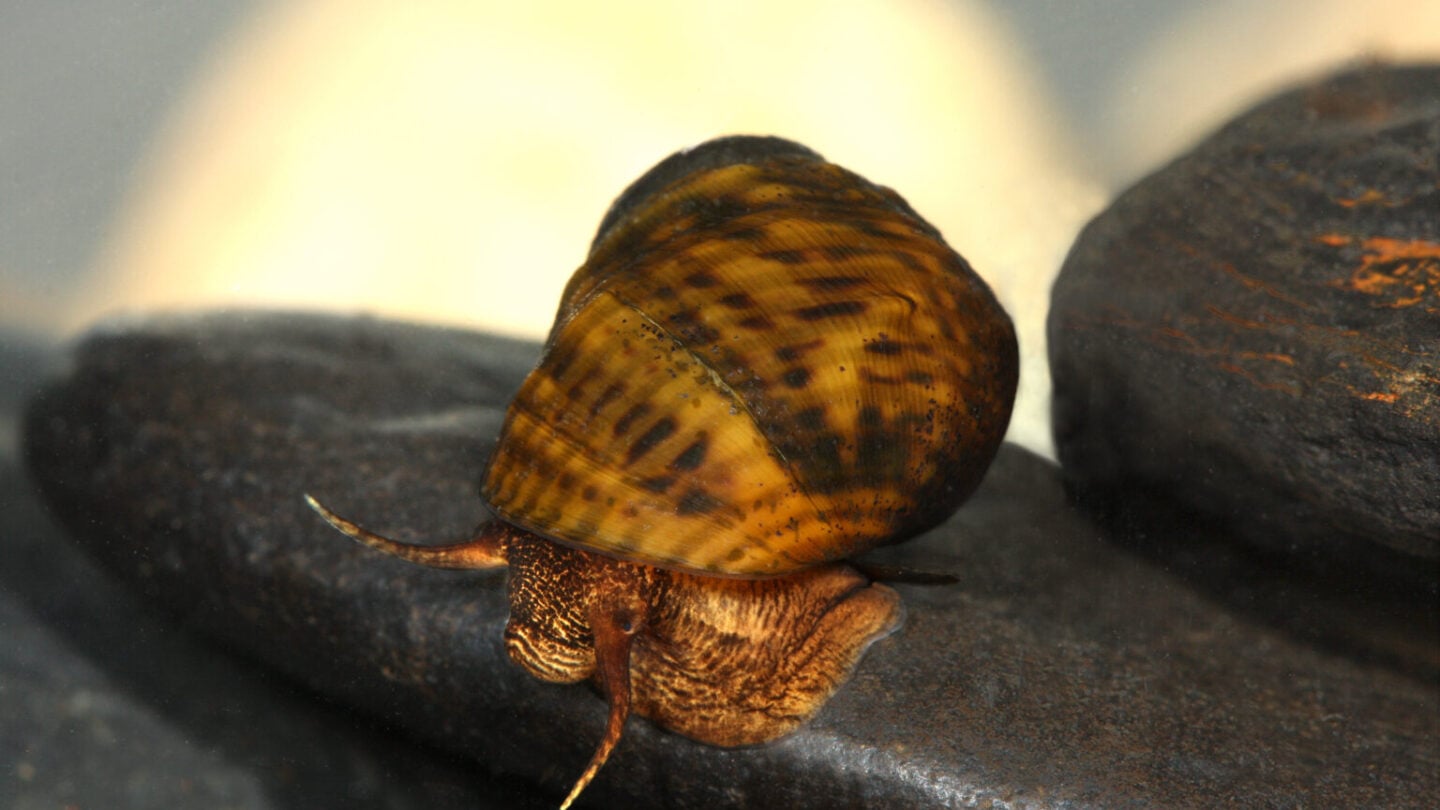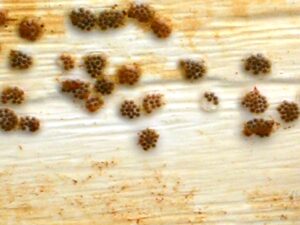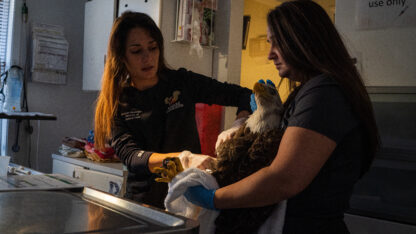Rare snail slowly crawls back from near extinction along northwest Georgia river

In a stretch of north Georgia river lives a snail that has come back from the dead.
The interrupted rocksnail, a slimy little orange guy, was once thought to be extinct, but in 1997, the United States Geological Survey found a single snail.
They called Paul Johnson, program supervisor at the Alabama Aquatic Biodiversity Center, who was working with the Tennessee Aquarium Research Institute in Georgia at the time, and he set out to the Oostanaula River to try to find more of the snails.
“Even for river buffs like me, it’s a pretty difficult river to work,” Johnson said. “We could only go in there like September, late August or September, maybe early October of the year, and that’s when the flows are optimal for you to try to find them. So it took two or three years to actually complete the survey.”
The researchers located enough snails to begin breeding them in captivity, and they’ve been releasing them in the thousands in an attempt to give them a second chance at life, first through the Tennessee Aquarium Conservation Institute and now through the Alabama Aquatic Biodiversity Center. The going hasn’t been easy.
“Because they’re rare, we don’t want to over collect animals when we’re doing this work,” he added. “And you can’t move them from one spot to the other. You can’t do that without endangering the small populations where they are.”
The interrupted rocksnail is native to the Coosa River system in Alabama and northwest Georgia and once crawled along hundreds of miles between those states. Today, the survivors are holding out in a small stretch of a Georgia river.
“They’re restricted to a couple of small sites in about eight miles of river,” Johnson said. “The window there is pretty narrow, and they have to have just the right habitat conditions within that eight miles, so that distribution is still really spotty. It’s certainly not a continuous eight miles. The distribution is choppy within there.”
Dams
Interrupted rocksnails evolved to fit a specific niche, but the damming of the Coosa River system in Alabama has changed their habitat and brought about their current misfortune, said Will Harlan, southeast director and senior scientist at the Center for Biological Diversity in Asheville, North Carolina.
“They just can’t live in standing water,” he said. “They in live free-flowing rivers that have sandy, stable substrate, boulders that they can attach to lay their eggs to, they stick their eggs and glue them onto the bouldery, cobbley bottoms of rivers, so if they get all silted and muddy from dams and impoundments, they’re not going to reproduce, the temperatures change, and they don’t have the flow they need because they’re also essentially bottom feeders, they feed on algae and bacteria that are floating by, and that just doesn’t happen in a lake or a pond.”
Damming this system has harmed countless other species, Johnson said.
Researchers have had some success placing the snails outside their current eight-mile domain in a bypass around a dam, a divergent channel of water that has proven to be a good habitat for other aquatic creatures, but the relocated snails are not doing as well as they’d like. Some of them are managing to survive in the wild, but they don’t seem to be breeding, Harlan said.
“We’re not seeing the juveniles, we’re not seeing the reproduction. So that’s a work in progress. And one of the hurdles is Alabama Power, trying to get them to agree to flow regimes and water quality and stable flows and temperatures in these bypasses and in these dams to ensure that there’s suitable habitat for the snails.”
Little helpers
Snails like the interrupted rocksnail are more than just pretty faces. They scrape up gunk from the bottom of the river using an organ called a radula, which is like a tongue covered in tiny teeth. Chowing down on river slime may be gross to some, but it’s an important duty for the aquatic community.
“They’re the vacuum cleaners of rivers,” Johnson said. “They and mussels. Most of our Southeast rivers historically, the biomass in the rivers were dominated by mussels and snails, and the mussels clean the water and the snails basically clean the rocks, so it makes a better habitat for small fishes that make more fish that feed big fishes, so they did have an upward impact.”
Snails also serve their community even in death, as crunchy snacks for their bigger neighbors.
“It’s obviously helping the water quality, but also, it’s really important for a lot of fish, even ducks, turtles, they all feed on this snail,” Harlan said. “So when this snail crashes, it affects the populations of a lot of freshwater species, and we’re seeing the populations really crash. And it has a really important effect for fishers, for folks who are fishing for drum and bass and other species in these rivers.”
The future
The snails’ survival in their current small domain is encouraging, Harlan said, but if they are to thrive long-term, they need to establish colonies in more of their past habitat.
Trusting the future of a species to one location could make them vulnerable to even a small-scale environmental contamination, Johnson said.
“We’re one bad bridge crossing away, a tanker truck wreck on a bridge crossing, from wiping out species,” he said.
Johnson had hoped the U.S. Senate would pass the Recovering America’s Wildlife Act, which would dedicate millions of federal dollars to Georgia’s Department of Natural Resources to protect threatened species like the interrupted rocksnail. But that measure did not make it into the $1.7 trillion spending package.
Politicians could also help out by reforming the way species are listed as endangered, Harlan said.
“Had it not taken so long to get this species listed, we might not be in the situation we are today,” he said. “It was proposed back in 1991, that’s over 30 years ago, we knew this snail was in trouble, but right now, the way the endangered species listing process currently works, it takes on average ten years for a species to get listed. There’s hundreds of species backlogged, waiting, so we really need some reform in how species are listed so this doesn’t keep occurring and these species don’t blink out while they’re waiting to be listed.”
In the meantime, the recovery efforts will continue, Harlan said, with the emphasis on Georgia’s waterways.
“Georgia is doing its job,” he said. “The rivers of Georgia look great. And we may try rivers, maybe like the Conasauga, which is world famous for its biodiversity and water quality. We know it was there historically, but it requires a lot of research to make sure you’re reintroducing something that you don’t have any cascading negative effects, but we know this snail was there previously.
“Georgia’s waters are looking great as suitable habitat, it’s downstream where more of the dams are in Alabama, and in the Coosa River watershed, that’s where we’re having more difficulties.”
This story was provided by WABE content partner Georgia Recorder.









